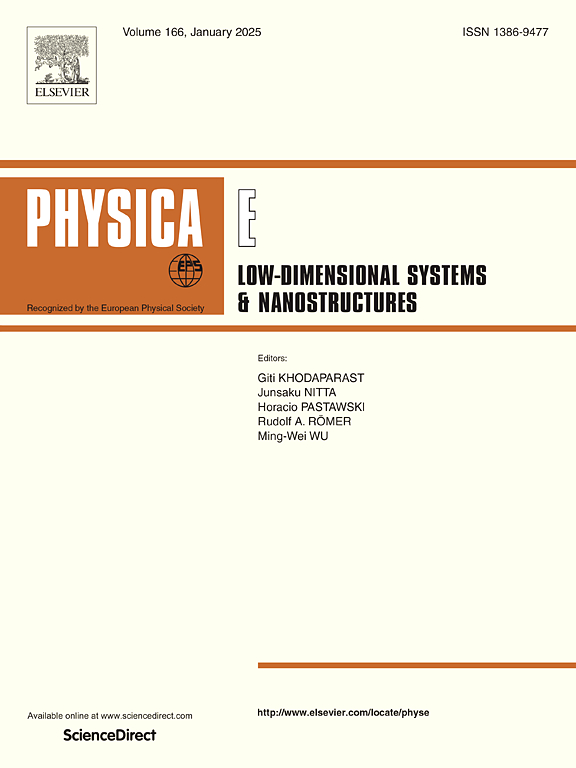理论研究了外加磁场、自旋轨道耦合和交换效应下Cd1-xMnxTe量子线的态密度和热性能
IF 2.9
3区 物理与天体物理
Q3 NANOSCIENCE & NANOTECHNOLOGY
Physica E-low-dimensional Systems & Nanostructures
Pub Date : 2025-07-03
DOI:10.1016/j.physe.2025.116326
引用次数: 0
摘要
本研究探讨了稀释磁性半导体Cd1-xMnxTe在量子线(QW)几何结构中的电子、热学和磁热特性。考虑Rashba自旋轨道相互作用(SOI)和交换相互作用,求解了外磁场作用下圆柱形量子线中电子的哈密顿量。利用得到的能量色散关系计算了电子结构、朗道能级和态密度。我们的分析表明,自旋分裂、Rashba SOI、交换相互作用和磁场强度对DOS有强烈的综合影响。通过调整这些参数,DOS模式可以针对特定的自旋电子应用进行优化。研究了磁热效应(MCE),揭示了低温状态下明显的磁热效应行为(T <;70 K)。结果表明,Cd1-xMnxTe量子线的磁性和热力学性质可以通过调节SOI强度、交换相互作用、温度和线约束来精确调制。这种可调性突出了这种材料在低温自旋电子应用、磁制冷技术方面的潜力。本文章由计算机程序翻译,如有差异,请以英文原文为准。
Theoretical study of the density of states and thermal properties of Cd1-xMnxTe quantum wire under the combined effects of the applied magnetic field, spin orbit coupling and exchange effects
This study investigates the electronic, thermal, and magnetocaloric properties of the diluted magnetic semiconductor Cd1-xMnxTe in quantum wire (QW) geometry. We solve the Hamiltonian for an electron confined in a cylindrical quantum wire under an external magnetic field, incorporating the Rashba spin–orbit interaction (SOI) and exchange interactions. The resulting energy dispersion relations are used to calculate the electronic structure, Landau levels and the density of states (DOS). Our analysis shows that the DOS is strongly influenced by the combined effects of spin splitting, Rashba SOI, exchange interaction, and magnetic field strength. By tuning these parameters, the DOS pattern can be optimized for specific spintronic applications. The magnetocaloric effect (MCE) is explored, revealing a pronounced MCE behavior in the low-temperature regime (T < 70 K). The results demonstrate that the magnetic and thermodynamic properties of Cd1-xMnxTe quantum wires can be precisely modulated by adjusting the SOI strength, exchange interaction, temperature, and wire confinement. This tunability highlights the potential of this material for low-temperature spintronic applications, magnetic refrigeration technologies.
求助全文
通过发布文献求助,成功后即可免费获取论文全文。
去求助
来源期刊
CiteScore
7.30
自引率
6.10%
发文量
356
审稿时长
65 days
期刊介绍:
Physica E: Low-dimensional systems and nanostructures contains papers and invited review articles on the fundamental and applied aspects of physics in low-dimensional electron systems, in semiconductor heterostructures, oxide interfaces, quantum wells and superlattices, quantum wires and dots, novel quantum states of matter such as topological insulators, and Weyl semimetals.
Both theoretical and experimental contributions are invited. Topics suitable for publication in this journal include spin related phenomena, optical and transport properties, many-body effects, integer and fractional quantum Hall effects, quantum spin Hall effect, single electron effects and devices, Majorana fermions, and other novel phenomena.
Keywords:
• topological insulators/superconductors, majorana fermions, Wyel semimetals;
• quantum and neuromorphic computing/quantum information physics and devices based on low dimensional systems;
• layered superconductivity, low dimensional systems with superconducting proximity effect;
• 2D materials such as transition metal dichalcogenides;
• oxide heterostructures including ZnO, SrTiO3 etc;
• carbon nanostructures (graphene, carbon nanotubes, diamond NV center, etc.)
• quantum wells and superlattices;
• quantum Hall effect, quantum spin Hall effect, quantum anomalous Hall effect;
• optical- and phonons-related phenomena;
• magnetic-semiconductor structures;
• charge/spin-, magnon-, skyrmion-, Cooper pair- and majorana fermion- transport and tunneling;
• ultra-fast nonlinear optical phenomena;
• novel devices and applications (such as high performance sensor, solar cell, etc);
• novel growth and fabrication techniques for nanostructures

 求助内容:
求助内容: 应助结果提醒方式:
应助结果提醒方式:


